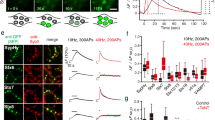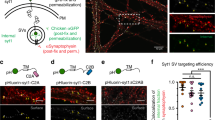Abstract
Activity elicits capture of dense-core vesicles (DCVs) that transit through resting Drosophila synaptic boutons to produce a rebound in presynaptic neuropeptide content following release. The onset of capture overlaps with an increase in the mobility of DCVs already present in synaptic boutons. Vesicle mobilization requires Ca2+-induced Ca2+ release by presynaptic endoplasmic reticulum (ER) ryanodine receptors (RyRs) that in turn stimulates Ca2+/calmodulin-dependent kinase II (CamKII). Here we show that the same signaling is required for activity-dependent capture of transiting DCVs. Specifically, the CamKII inhibitor KN-93, but not its inactive analog KN-92, eliminated the rebound replacement of neuropeptidergic DCVs in synaptic boutons. Furthermore, pharmacologically or genetically inhibiting neuronal sarco-endoplasmic reticulum calcium ATPase to deplete presynaptic ER Ca2+ stores or directly inhibiting RyRs prevented the capture response. These results show that the presynaptic RyR–CamKII pathway, which triggers mobilization of resident synaptic DCVs to facilitate exocytosis, also mediates activity-dependent capture of transiting DCVs to replenish neuropeptide stores.



Similar content being viewed by others
References
Ataman, B., Ashley, J., Gorczyca, M., Ramachandran, P., Fouquet, W., Sigrist, S. J., et al. (2008). Rapid activity-dependent modifications in synaptic structure and function require bidirectional Wnt signaling. Neuron, 57, 705–718.
Barkus, R. V., Klyachko, O., Horiuchi, D., Dickson, B. J., & Saxton, W. M. (2008). Identification of an axonal kinesin-3 motor for fast anterograde vesicle transport that facilitates retrograde transport of neuropeptides. Molecular Biology of the Cell, 19, 274–283.
Frischknecht, R., Fejtova, A., Viesti, M., Stephan, A., & Sonderegger, P. (2008). Activity-induced synaptic capture and exocytosis of the neuronal serine protease neurotrypsin. Journal of Neuroscience, 28, 1568–1579.
Guillaud, L., Wong, R., & Hirokawa, N. (2008). Disruption of KIF17–Mint1 interaction by CaMKII-dependent phosphorylation: a molecular model of kinesin-cargo release. Nature Cell Biology, 10, 19–29.
Levitan, E. S., Lanni, F., & Shakiryanova, D. (2007). In vivo imaging of vesicle motion and release at the Drosophila neuromuscular junction. Nature Protocols, 2, 1117–1125.
Pack-Chung, E., Kurshan, P. T., Dickman, D. K., & Schwarz, T. L. (2007). A Drosophila kinesin required for synaptic bouton formation and synaptic vesicle transport. Nature Neuroscience, 10, 980–989.
Rao, S., Lang, C., Levitan, E. S., & Deitcher, D. L. (2001). Visualization of neuropeptide expression, transport, and exocytosis in Drosophila melanogaster. Journal of Neurobiology, 49, 159–172.
Sanyal, S., Consoulas, C., Kuromi, H., Basole, A., Mukai, L., Kidokoro, Y., et al. (2005). Analysis of conditional paralytic mutants in Drosophila sarco-endoplasmic reticulum calcium ATPase reveals novel mechanisms for regulating membrane excitability. Genetics, 169, 737–750.
Shakiryanova, D., Tully, A., Hewes, R. S., Deitcher, D. L., & Levitan, E. S. (2005). Activity-dependent liberation of synaptic neuropeptide vesicles. Nature Neuroscience, 8, 173–178.
Shakiryanova, D., Tully, A., & Levitan, E. S. (2006). Activity-dependent synaptic capture of transiting peptidergic vesicles. Nature Neuroscience, 9, 896–900.
Shakiryanova, D., Klose, M. K., Zhou, Y., Gu, T., Deitcher, D. L., Atwood, H. L., et al. (2007). Presynaptic ryanodine receptor-activated calmodulin kinase II increases vesicle mobility and potentiates neuropeptide release. Journal of Neuroscience, 27, 7799–7806.
Ziv, N. E., & Garner, C. C. (2004). Cellular and molecular mechanisms of presynaptic assembly. Nature Reviews, 5, 385–399.
Zupanc, G. K. (1996). Peptidergic transmission: from morphological correlates to functional implications. Micron, 27, 35–91.
Acknowledgments
This research was supported by NIH grant NS32385.
Author information
Authors and Affiliations
Corresponding author
Rights and permissions
About this article
Cite this article
Wong, M.Y., Shakiryanova, D. & Levitan, E.S. Presynaptic Ryanodine Receptor–CamKII Signaling is Required for Activity-dependent Capture of Transiting Vesicles. J Mol Neurosci 37, 146–150 (2009). https://doi.org/10.1007/s12031-008-9080-8
Received:
Accepted:
Published:
Issue Date:
DOI: https://doi.org/10.1007/s12031-008-9080-8




